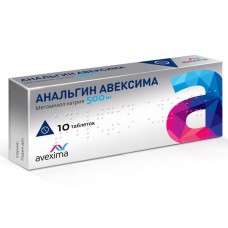Expiration date: 10/2026
Pharmacological action
Pharmacodynamics
Analgin non-selectively inhibits cyclooxygenase and reduces the formation of prostaglandins from arachidonic acid, prevents the conduction of pain of extra - and proprioceptive impulses. Analgin has a poorly expressed anti-inflammatory effect, causing little impact on water-salt metabolism (delay sodium and water) and gastrointestinal mucosa. Has antispasmodic effect on smooth muscles of urinary and biliary tract. The effect develops in 20-40 minutes after ingestion.
Pharmacokinetics
Well and rapidly absorbed from the gastrointestinal tract, which ensures the rapid development of clinical effect. When taken in therapeutic doses, penetrates into breast milk. The maximum concentration in plasma achieved through 1-1. 5 h after ingestion. In the bowel wall hydrolyses education active metabolite, 4-methyl-aminoantipyrine, which in turn is metabolized to 4-formyl-amino - antipyrine and other metabolites. The level of binding of the active metabolite to proteins is 50-60 %. Excretion of metabolites is via the kidneys. In addition, the metabolites are excreted in breast milk.
Testimony
Feverish syndrome on the background of infectious inflammatory diseases, headache of different origin pain syndrome mild to moderate severity:
- neuralgia;
- myalgia;
- arthralgia;
- biliary colic;
- intestinal colic;
- renal colic;
- injury;
- sciatica;
- myositis;
- postoperative pain;
- algomenorrhea.
Contraindications
- Hypersensitivity;
- oppression blood (agranulocytosis, neutropenia);
- liver and/or kidney failure;
- hereditary hemolytic anemia associated with a deficit glukozo - 6-fosfatdegidrogenaza, and other types of anemia;
- asthma induced by acetylsalicylic acid, salicylates and other nonsteroidal anti-inflammatory drugs;
- leukopenia;
- pregnancy (especially in I trimester and in the last 6 weeks) and lactation;
- children up to age 8 years.
Caution: you should take the drug for kidney disease (pyelonephritis, glomerulonephritis – including in history), with moderately expressed violations of the liver and kidney, bronchial asthma, predisposition to arterial hypotension, prolonged alcohol abuse.
Application of pregnancy and breastfeeding
Contraindicated in pregnancy and breastfeeding.
Special instructions
In the treatment of children up to 8 years and of patients receiving cytotoxic drugs, receive of DIPYRONE should be carried out only under the supervision of a physician.
In patients with atopic bronchial asthma and hay fever have an increased risk of allergic reactions.
In patients receiving DIPYRONE may develop agranulocytosis, and therefore, the detection of unmotivated rise in temperature, chills, sore throat, difficulty swallowing, stomatitis, as well as the development of the phenomena of vaginitis or proctitis required the immediate withdrawal of the drug.
Long-term use must be monitored picture peripheral blood. Not be used to relieve acute abdominal pain (to determine cause).
Composition
1 tablet contains:
Active substances: active substance: Metamizole sodium – 500 mg.
Auxiliary substances: potato starch, calcium stearate, sucrose (sugar), talc.
Method of application and doses
Inside, after eating.
Adults appoint 250-500 mg 2-3 times a day, the maximum single dose of 1000 mg daily to 3000 mg.
Single dose for children 8-14 years – 250-300 mg, the multiplicity of purposes 2-3 times a day.
The length of treatment without consulting a doctor no more than 5 days.
Side effects
From the urinary system: impaired renal function, oliguria, anuria, proteinuria, interstitial nephritis, urine staining in red.
Allergic reactions: urticaria (including conjunctiva and mucous membranes of the nose and throat), angioedema, in rare cases – malignant exudative erythema (Stevensjohnson syndrome), toxic epidermal necrolysis (Lyell's syndrome), bronchospastic syndrome, anaphylactic shock.
Organs of hematopoiesis: agranulocytosis, leukopenia, thrombocytopenia.
Other: lowering blood pressure.
Drug interactions
Simultaneous administration with other non-narcotic analgesics, tricyclic antidepressants, contraceptive hormonal medicines and allopurinol may lead to increased toxicity; sedative and anxiolytic drugs increase the analgesic effect of metamizol sodium.
Metamizole sodium enhances the effects of alcohol; simultaneous application with chlorpromazine or phenothiazines may lead to the development of severe hyperthermia.
Radiopaque drugs, colloidal blood substitutes and penicillin should not be used during treatment with Metamizole sodium.
When concomitant administration of cyclosporine decreases the concentration of the latter in the blood.
Metamizole, displacing connection with protein oral hypoglycemic drugs, indirect anticoagulants, corticosteroids and indomethacin, increase their activity.
Phenylbutazone, barbiturates and other inducers of microsomal oxidation liver while appointing reduce the effectiveness of metamizol sodium.
Overdose
Symptoms: nausea, vomiting, gastralgia, oliguria, hypothermia, decreased blood pressure, tachycardia, dyspnea, tinnitus, drowsiness, delirium, impaired consciousness, acute agranulocytosis, hemorrhagic syndrome, acute renal and/or hepatic failure, convulsions, paralysis of the respiratory muscles.
Treatment: gastric lavage, saline laxatives, activated carbon, conducting forced diuresis, hemodialysis, the development of seizures is intravenous administration of diazepam fast-acting barbiturates.



